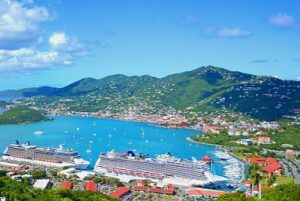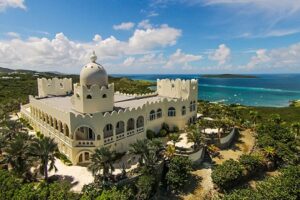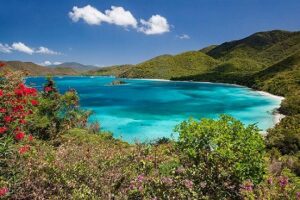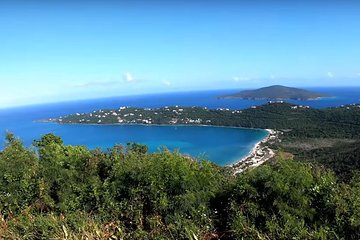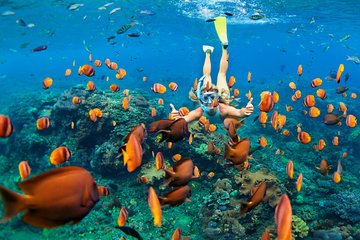UNITED STATES VIRGIN ISLANDS TRAVEL GUIDE
What to see and what to do in U.S. Virgin Islands
Saint Croix, Saint John, Saint Thomas, Charlotte Amalie, Christiansted, Frederiksted, are only a few of many amazing places in U.S. Virgin Islands. Use our U.S. Virgin Islands Travel Guide for information, idea and travel tips. Read our travel descriptions and see images and videos for inspiration. We have selected the best tours and activities for you, and we give our recommendations. We have researched, testet and and verified our partners, so you can enjoy easy and safe booking – on the GO!
Useful links:
Useful links: U.S. Virgin Islands official website – What Wikipedia says about Virgin Islands
U.S. Virgin Islands: Activities and Tours – Calendar – Accommodation – Car Rental – Concert Tickets – Sport Tickets – Book Flight – Train and Bus – Airport Transfer
Internal links: States – Cities – National Parks – Transport – Sport – Contact Us
VIRGIN ISLANDS VIDEO INSPIRATION
RECOMMENDED TOURS AND ACTIVITIES
Facts about US Virgin Islands
Get these answers below:

Where is the Virgin Islands located?
The Islands are located in the Atlantic Ocean, about 40 miles (64 KM) east of Puerto Rico and west of the British Virgin Islands
Facts
The U.S. Virgin Islands consists of the main islands of Saint Croix, Saint John and Saint Thomas. The total land area of the territory is 133.73 square miles (346.36 km2). The territory’s capital is Charlotte Amalie on the island of St. Thomas.
In 2021 the estimated population is apx 105,000. Most of the population being of Afro-Caribbean descent. Tourism and related categories are the primary economic activities.
The U.S. Virgin Islands are organized under the 1954 Revised Organic Act of the Virgin Islands and have since held five constitutional conventions.
Major airports
- Cyril E. King Airport (STT) on St. Thomas
- Henry E. Rohlsen Airport (STX) on St. Croix
Introduction
The US Virgin Islands a group of exotic islands located in the Caribbean Sea. The islands was bought from the Kingdom of Denmark in 1917, and is now a US territory. Before 1917 the islands was called The Danish West Indies, and was a colony of Denmark. The islands consist of three main islands – St. Croix, St. John and St. Thomas – plus apx. 50 smaller islands in the Caribbean sea.
The US Virgin Islands is located 1,100 miles from Miami and 1,650 miles from New York City. Thus, it is only a short flight from the continental United States. The beautiful landscape is called “America’s Paradise.” A year-round destination that has no real “off” season with an average winter temperature of 82 degrees F. (slightly higher in summer). Here the weather is almost always perfect for the beach. The islands are famous for its beautiful white sandy beaches and turquoise waters. Spend the day relaxing in a beachchair and enjoy a top 10 beach in the world.
Weather
Top attractions
- Trunk Bay, St. John: Known for its stunning beauty, Trunk Bay features a pristine beach, crystal-clear turquoise waters, and an underwater snorkeling trail.
- Magens Bay, St. Thomas: Considered one of the most beautiful beaches in the Caribbean, Magens Bay offers a mile-long stretch of white sand, calm waters, and lush surroundings.
- Buck Island Reef National Monument, St. Croix: This protected marine park is renowned for its incredible underwater snorkeling trails, vibrant coral reefs, and diverse marine life.
- Coral World Ocean Park, St. Thomas: A popular family attraction, Coral World offers interactive experiences with marine life, including swimming with sea lions, feeding stingrays, and exploring an underwater observatory.
- Blackbeard’s Castle, St. Thomas: A historic site in Charlotte Amalie, Blackbeard’s Castle is a watchtower dating back to the 17th century. Visitors can enjoy panoramic views, explore the historic tower, and learn about pirate lore.
- Caneel Bay, St. John: Located within Virgin Islands National Park, Caneel Bay boasts picturesque beaches, lush tropical landscapes, and excellent snorkeling opportunities.
- Christiansted, St. Croix: This charming town on St. Croix features colorful Danish colonial architecture, historic landmarks, art galleries, and boutique shops. The Christiansted National Historic Site showcases the island’s history.
- Virgin Islands National Park, St. John: Covering over 60% of the island, this national park offers breathtaking natural beauty, hiking trails, pristine beaches, and rich biodiversity.
- Mahogany Run Golf Course, St. Thomas: Golf enthusiasts can enjoy a round of golf at this scenic course with stunning views of the Caribbean Sea and challenging holes.
- Annaberg Plantation, St. John: A historical site within Virgin Islands National Park, Annaberg Plantation provides insight into the island’s sugar plantation era. Visitors can explore ruins, learn about the island’s history, and enjoy panoramic views.
Scenic places
- Trunk Bay, St. John: Trunk Bay is often referred to as one of the most beautiful beaches in the Caribbean. It features powdery white sand, crystal-clear turquoise waters, and vibrant coral reefs. The beach offers breathtaking views and is renowned for its underwater snorkeling trail.
- Magens Bay, St. Thomas: Magens Bay is a picturesque beach that stretches for a mile along a horseshoe-shaped bay. The beach is surrounded by lush green hills, creating a tranquil and scenic atmosphere. Its calm waters make it ideal for swimming, and the beach is often rated as one of the top beaches in the world.
- Virgin Islands National Park, St. John: Covering a significant portion of St. John, the Virgin Islands National Park is a haven of natural beauty. The park features pristine beaches, dense forests, hiking trails, and breathtaking viewpoints. Scenic spots within the park include Cinnamon Bay, Hawksnest Bay, and the famous Trunk Bay.
- Salt Pond Bay, St. John: Salt Pond Bay is a secluded and picturesque beach located in the southern part of St. John. It offers beautiful turquoise waters, rocky cliffs, and a diverse marine ecosystem. The beach is known for its excellent snorkeling opportunities and a nearby salt pond that adds to its natural charm.
- Annaly Bay Tide Pools, St. Croix: The Annaly Bay Tide Pools are a hidden gem on the island of St. Croix. Accessed via a scenic hike, these natural tide pools are nestled within dramatic cliffs and offer a unique swimming experience. Visitors can enjoy stunning views of the surrounding coastline and the Caribbean Sea.
- Brewers Bay, St. Thomas: Brewers Bay is a picturesque beach located on the northwestern coast of St. Thomas. It is known for its calm, crystal-clear waters and beautiful sandy shoreline. The bay is surrounded by lush green hills and provides a peaceful and scenic setting for beachgoers.
- Coral Bay, St. John: Coral Bay is a charming and laid-back town located on the eastern side of St. John. It offers panoramic views of the surrounding hills, coral reefs, and turquoise waters. The area is known for its tranquil atmosphere, local shops, and restaurants.
- Drake’s Seat, St. Thomas: Located high on a hillside overlooking Magens Bay, Drake’s Seat offers panoramic views of the bay, surrounding islands, and the Caribbean Sea. It is named after the famous explorer Sir Francis Drake and provides a stunning vantage point for sunset viewing.
Getting around
- Rental Cars: Renting a car is a popular option for exploring the islands at your own pace. There are various car rental agencies available at the airports and in major towns. It is advisable to book in advance, especially during peak tourist seasons.
- Taxis: Taxis are readily available on the islands, particularly at the airports, major hotels, and popular tourist areas. It’s important to note that taxi fares are typically regulated, and you can find official taxi rates posted at the airport and other designated areas.
- Public Transportation: The U.S. Virgin Islands offer public transportation in the form of buses on the main islands of St. Thomas and St. Croix. On St. Thomas, the bus system is called the “VITRAN” and operates regular routes throughout the island. On St. Croix, the bus system is known as the “Safari Bus” or “VITRAN” and provides transportation to various destinations.
- Ferries: For island hopping or visiting neighboring islands, ferries are available. There are ferry services connecting St. Thomas, St. John, and the British Virgin Islands. These services offer a convenient way to explore different islands and enjoy scenic boat rides.
- Water Taxis: Water taxis are another means of transportation, especially for shorter distances and visiting nearby beaches or attractions. They can be found at marinas or popular waterfront areas.
Local cuisine
- Seafood: Given its island location, seafood plays a prominent role in the local cuisine. Freshly caught fish like mahi-mahi, snapper, and grouper are popular choices, often prepared grilled, fried, or in flavorful stews.
- Conch: Conch is a shellfish commonly found in the Caribbean, and it features prominently in the U.S. Virgin Islands’ cuisine. Conch fritters, conch chowder, and conch salad are popular dishes that highlight the tender meat of this mollusk.
- Johnny Cakes: Johnny Cakes are a staple in the Virgin Islands and are similar to cornbread or fried dough. They are made with a mixture of cornmeal, flour, sugar, and baking powder, then fried until golden brown. They are often enjoyed as a breakfast item or as a side with savory dishes.
- Callaloo: Callaloo is a popular vegetable dish made from leafy greens such as taro leaves or amaranth, along with various other ingredients like okra, onions, and spices. It is typically cooked into a thick stew or soup and served as a side dish or even as a main course with rice.
- Roti: Roti is a Caribbean flatbread that is commonly enjoyed in the U.S. Virgin Islands. It is made from a dough of flour, water, and sometimes infused with flavors like turmeric or cumin. Roti is often filled with curried meats, vegetables, or seafood to create a flavorful and satisfying meal.
- Pates: Pates are savory turnovers that have become a popular snack in the U.S. Virgin Islands. These pastries are typically filled with spiced meat, fish, or vegetable fillings, and then baked or fried until golden and crispy.
- Local Fruit: The U.S. Virgin Islands are blessed with an abundance of tropical fruits. Mangoes, papayas, passion fruit, guavas, and soursop are just a few examples of the delicious fruits you can find. They are often enjoyed fresh, juiced, or incorporated into desserts and smoothies.
- Cruzan Rum: The U.S. Virgin Islands, particularly St. Croix, are renowned for producing Cruzan Rum. This locally produced rum is used to create refreshing cocktails such as the Painkiller, made with rum, pineapple juice, orange juice, and cream of coconut.
Places to stay as a tourist
Major events and festivals
- Carnival: Carnival is the most anticipated and celebrated event in the U.S. Virgin Islands. It takes place in the weeks leading up to Easter and features colorful parades, extravagant costumes, music, dancing, and a lively atmosphere. Each island has its own carnival celebration, with St. Thomas hosting one of the largest and most famous carnivals in the Caribbean.
- Crucian Christmas Festival: The Crucian Christmas Festival is a month-long celebration on the island of St. Croix, held in December and early January. The festival includes a wide range of events, such as parades, music concerts, beauty pageants, food fairs, cultural performances, and fireworks. It showcases the unique traditions, music, and cuisine of St. Croix.
- St. John Festival: The St. John Festival is a week-long celebration in late June and early July, showcasing the culture and heritage of the island of St. John. The festival includes a colorful parade, live music performances, local food and drinks, beauty pageants, and various cultural events. It culminates in a spectacular fireworks display.
- Agrifest: Agrifest, also known as the St. Croix Agriculture and Food Fair, is a three-day agricultural festival held in February on St. Croix. It celebrates the rich agricultural heritage of the island and showcases local produce, livestock exhibitions, cooking demonstrations, crafts, music, and traditional dances.
- Emancipation Day: Emancipation Day is celebrated on July 3rd in the U.S. Virgin Islands to commemorate the abolition of slavery in the Danish West Indies (now the U.S. Virgin Islands) in 1848. The day is marked with parades, cultural performances, historical reenactments, and ceremonies honoring the freedom fighters.
- Transfer Day: Transfer Day is celebrated on March 31st to commemorate the transfer of the U.S. Virgin Islands from Danish to American control in 1917. The day is marked with ceremonies, parades, historical exhibitions, and cultural activities that highlight the islands’ history and the influence of Danish culture.
- Virgin Islands Carnival Parade: The Virgin Islands Carnival Parade takes place on St. Thomas and St. Croix in early January. The parades feature extravagant floats, live music, vibrant costumes, and enthusiastic crowds celebrating the spirit of carnival. It is a fun-filled event that attracts both locals and visitors.

